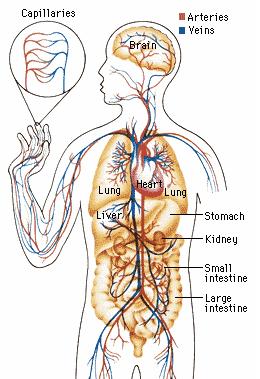Liver is the largest gland in the human body and one of the most complex of all human organs. It serves as the body's main chemical factory and is one of its major storehouses of food. The liver is a reddish-brown mass weighing about 3 pounds (1.4 kilograms). It is located in the upper right part of the abdomen, under the diaphragm and above the stomach and intestines.
The liver probably performs more separate tasks than any other organ in the body. Its chief functions are to help the body digest and use food and to help purify the blood of wastes and poisons.
Digestion and use of food. The secretion of bile ranks as one of the liver's most important digestive functions. Bile consists of bile salts and several other substances. The bile salts act on fats in the small intestine. They help break up globs of fat so enzymes in the intestine can convert fat molecules to fatty acids and glycerol.
The liver also regulates the amount of certain nutrients that the cells of the body receive. Digestive enzymes in the intestine break down proteins into amino acids, and carbohydrates into simple sugars, primarily glucose. The blood carries these nutrients, as well as vitamins, minerals, and fatty acids and glycerol, to the liver. The liver removes the excess glucose from the blood and stores it in the form of a starchlike compound called glycogen. Glucose serves as the chief fuel for the body's cells. When the body needs energy, the liver converts glycogen to glucose and releases it into the blood. The liver also converts fatty acids and amino acids into glucose when its store of glycogen is low. In this way, the liver helps ensure that the cells of the body receive a constant supply of fuel.
The liver also plays an essential role in the storage of certain vitamins. The liver stores vitamin A, as well as vitamins D, E, and K, and those of the B-complex group. It also stores iron and other minerals.
Purification of the blood. Liver cells filter harmful substances from the blood. Such substances include insecticides, drugs, food additives, and industrial chemicals. Enzymes in the liver cells convert some of these substances into products that dissolve in water. The blood transports the substances to the kidneys, which discharge them in urine. Other harmful substances are excreted in the bile. The liver also filters many bacteria, viruses, and other microorganisms from the blood. Special liver cells surround these microorganisms and chemically digest them.
In addition, the liver filters out waste substances produced by the body. When red blood cells die, they release hemoglobin, the compound that enables them to carry oxygen. Cells in the liver and other organs break down hemoglobin into several substances, including iron and a reddish-yellow pigment called bilirubin. The liver discharges bilirubin in bile. It stores iron for use in producing new red blood cells. The liver also rids the body of ammonia, a poisonous waste formed when amino acids are changed to other compounds in the liver. The liver converts the ammonia to urea, which is eventually discharged in urine.
Other functions. The liver manufactures various blood proteins, including albumin, globulins, and fibrinogen. Albumin helps to prevent plasma (the liquid portion of the blood) from seeping through the walls of the blood vessels. Globulins help the body fight infections. Fibrinogen enables the blood to seal broken blood vessels by forming a clot.
The liver also secretes cholesterol, a fatty substance. The body uses cholesterol to build cell membranes and to manufacture certain hormones, including the sex hormones. Hormones are chemicals that influence various body functions. Liver cells use cholesterol to manufacture bile salts.
|


